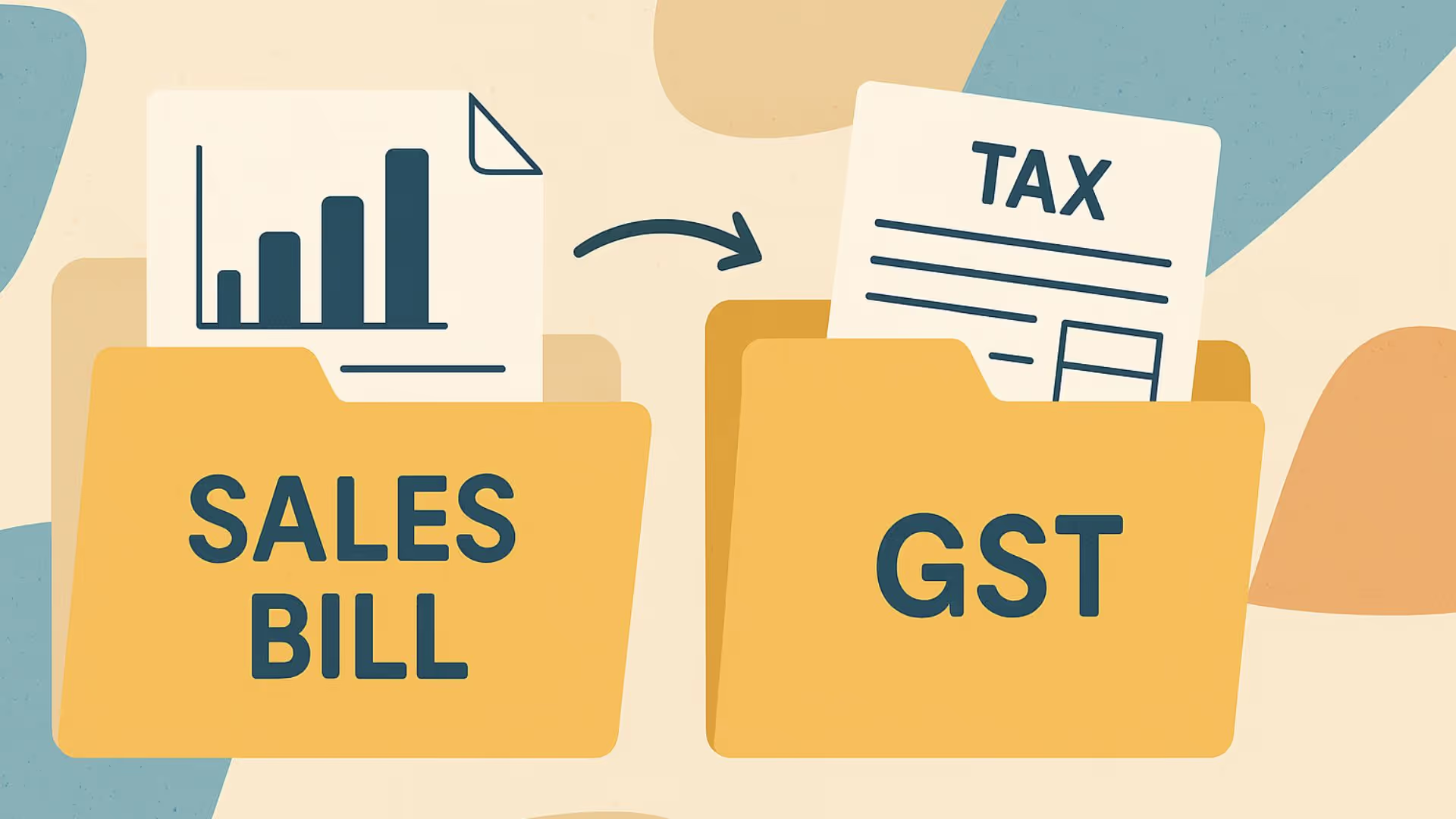

India implemented the Goods and Service Tax (GST) in 2017, replacing older indirect taxes like VAT, Excise, and Service Tax, with an integrated, all-in-one system.
For sales teams, this means completely changing the way they created invoices, handled returns, and planned their pricing and account structures.
In this blog, we’ll explain how GST affects sales invoicing and finance management. Start reading!
What is GST, and how does it apply to sales?
This affects a business's pricing, billing, and how they manage returns in a sales environment.
GST-compliant sales invoices
A GST invoice must contain the following information for each sale:
Supplier and customer details: Name, address, and GSTIN (tax ID) of your company and the buyer.
Invoice number & date: A unique, chronological number and the billing date.
Item details: Description of goods or services, HSN/SAC code (classification), quantity and unit price.
Taxable value and taxes: The value of goods/services before tax, plus the GST rate and the exact tax amount.
Tax breakdown: For intra-state sales, show CGST and SGST separately (each half of the rate). For inter-state sales, show IGST (the combined rate).
Total amount: Sum of the taxable value and all taxes (the final price charged).

For example, if you sell a product worth ₹20,000 at an 18% GST rate:
- If the sale is within your state, the invoice will charge 9% CGST (₹1,800) and 9% SGST (₹1,800). The customer pays ₹23,600 total.
- If the sale is to another state, the invoice will charge 18% IGST (₹3,600) and again total ₹23,600
How to handle free samples or discounts?
Discounts on invoices: If a 10% discount is applied to a product worth ₹20,000 at 18% GST, the taxable value becomes ₹18,000. The GST (₹3,240) is calculated on this discounted value, and the total invoice amount is ₹21,240. Discounts must always be reflected on invoices to avoid complications.
Scenario: A customer gets a 10% discount on a product worth ₹20,000 (GST rate 18%).
Invoice Details:
- Taxable Value: ₹18,000 (after discount).
- CGST: ₹810, SGST: ₹810.
- Total Invoice Amount: ₹19,620.
Advance payments: If a customer pays ₹10,000 in advance for a service worth ₹50,000, GST at 18% (₹1,800) is applicable on the advance. This must be captured in the invoice and adjusted during final billing.
Scenario: A customer pays ₹10,000 in advance for a service worth ₹50,000 (GST rate 18%).
Invoice Details (for advance):
- Taxable Value: ₹10,000.
- GST: ₹1,800.
- Total: ₹11,800.
- Adjust the advance payment in the final invoice.
GST breakdown today is automatically generated by modern billing systems.
Also, if you’re issuing e-invoicing, there are certain rules to follow: if the turnover of your business is ₹5 crores, you’re supposed to generate an electrical invoice via the govt. portal. This means uploading your invoice online as soon as you bill. E-invoicing helps automate GST returns but is an additional step to learn for large businesses.
Here’s a deep dive into all the types of GST:
Handling sales returns in GST
What happens when a customer cancels an order or returns it? There is a clear procedure for handling sales returns in GST. The seller issues a credit note, also known as a negative invoice, to reduce the amount owed by the customer.
For example, if a ₹20,000 invoice (with ₹3,600 GST) is cancelled, a credit note for ₹23,600 is issued and tax liability is reduced in the same period.

When a credit note is issued, it adjusts the GST liability by reducing the particular amount (the return or cancellation fee). You must also ensure that this is reflected in your monthly GST returns (GSTR-1 and 3B).
Remember, there’s a deadline to issue this credit note: on or before 30th November (or the date you file the annual return for that year). If you miss the deadline, you can no longer adjust your taxes for that return, therefore affecting your cash flow.
How is a GST sales entry recorded?
When making a sale:
- Enter taxable value.
- Apply the correct GST rate.
- Split tax amounts into CGST, SGST/UTGST, or IGST.
- Update customer ledger.
- Generate and save invoices.
- Record in the sales register and tax reports.
Tally and Quickbooks are software that help you manage this process. However, the accuracy of the data you input depends on you.
Common GST Rates in India (as of 2025):
Here’s the basic flow for a credit sale:
Debit Accounts Receivable for the total invoice amount (product price + GST).
Credit Sales Revenue for the price (before tax).
Credit GST Liability Accounts for the tax portion: if intra-state, credit both CGST and SGST accounts; if inter-state, credit the IGST account.
Let’s understand with an example. Suppose you sell 15,000 worth of good at an 18% GST(intra-state), your entries would look something like this:
Debit Debtors/AR ₹17,700.
Credit Sales A/C ₹15,000.
Credit CGST Payable ₹1350.
Credit SGST Payable ₹1350.
When you make a sale, the ₹1350 is recorded as GST liability until you pay it to the government. It’s crucial to keep these figures separate because when you file for GSTR-1 (your monthly or quarterly return), you report all the sales details, including your business turnover and the tax you charged.
Then, in GSTR-3 (your summary or return), you declare your total sales, the GST you collected, and even ITC (Input Tax Credit), which is the GST you paid while buying from suppliers.
From there, you calculate the net GST you need to pay or claim as a refund. At the end of the year, when you file for GSTR-9 (your annual return), all the details you filed for throughout the year match, resulting in a fair settlement.
Key implications of GST on sales billing
🧾 Standardized invoicing
Since GST has replaced many older taxes, there are mandatory fields all invoices must include, creating a standard format simplifying tax computation and reporting.
🌪️ Reduced cascading effect
By allowing businesses to file for ITC, it has largely eliminated the “tax on tax” system which previously existed in the indirect tax regime. This way, the net calculation of how much to pay to the govt (or claim as refund) is precise figures.
✅ Simplified interstate transactions
Previously, businesses had to maintain records of separate tax rates between states. With the introduction of Integrated Goods and Services Tax (IGST), billing for interstate transactions are streamlined, and simpler.
🏷️ Impact on discounts and free samples
GST implications are complex on post sale discounts, incentives and free samples. It is crucial for businesses to understand the difference between trade discounts (reflected on the invoice) and incentives (often treated as separate supplies subject to GST) for accurate ITC renewals and tax calculations.
Key implications of GST on financial management
💵 Cash flow management
GST mandates all businesses to regularly pay taxes (monthly, quarterly, or annually depending on turnover) which demands careful budgeting and cash flow planning to avoid penalties. If you delay claiming ITC, it can affect your liquidity as well.
🙇♀️ Increased compliance burden (initially)
While GST aimed to simplify the taxing process, it was confusing initially, especially for small and medium enterprises (SMEs). Companies had to train their employees for regular filings, comply with new rules, tweak their infrastructure and account systems.
⚙️ IT system upgrades
For invoices to be accurate and to track ITC returns efficiently, businesses ought to invest heavily in technology like accounting systems and ERP software which is GST compliant.
📈 Impact on pricing and profit margins
Businesses must carefully evaluate their cost structure and pricing to remain competitive in the market because of the change in tax rates for various goods and services under GST.
💰 Working capital
The timing of ITC claims can affect working capital. Delays in receiving ITC refunds or managing discrepancies can tie up funds for businesses.
🗃️ Enhanced record-keeping
It is mandatory under GST for businesses to maintain a detailed record of all the purchases, sale, tax liability, and ITC claims. An organized record makes it easier in case of return filing and audits, and eliminating discrepancies.
Conclusion
The entire responsibility of GST does not rest upon the finance teams. If you’re a sales executive and are managing sales bills/returns, it is important for you to understand how your transactions are affected by the tax, helping your business tailor a suitable sales process, and keep tax records and cash flow clean.
Heading text
Nunc sed faucibus bibendum feugiat sed interdum. Ipsum egestas condimentum mi massa. In tincidunt pharetra consectetur sed duis facilisis metus. Etiam egestas in nec sed et. Quis lobortis at sit dictum eget nibh tortor commodo cursus.
Odio felis sagittis, morbi feugiat tortor vitae feugiat fusce aliquet. Nam elementum urna nisi aliquet erat dolor enim. Ornare id morbi eget ipsum. Aliquam senectus neque ut id eget consectetur dictum. Donec posuere pharetra odio consequat scelerisque et, nunc tortor.
Nulla adipiscing erat a erat. Condimentum lorem posuere gravida enim posuere cursus diam.
.svg)






